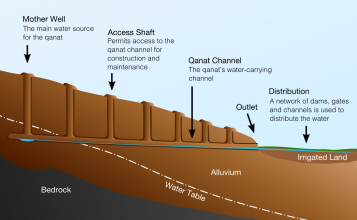Blog Post: The Qanat, A Sustainable Innovation From Ancient Iran

Being a civil engineering student I am always fascinated by new technologies, firstly for their ingenuity, and secondly for their lack of the same. In several quoted articles and images below I highlight how engineers thousands of years ago developed systems that were arguably much more sustainable as compared to many of our supposedly advanced unsustainable modern engineering systems that rely heavily on energy inputs.
Engineers thousands of years ago knew (as we should today) that systems with less moving parts, less energy - time - or value inputs, working in a symbiotic way with the environment will yield long term truly sustainable building energy management systems.
The example I will focus on in this blog is: Qanat [Kareez] systems(underground hand-dug tunnels for extracting groundwater in the dry and semi-arid regions of Iran and I will reference the works of many engineers and scholars who have come before me).

source: http://en.wikipedia.org/wiki/File:Qanat_cross_section.svg [1]
Paul Ward English describes Qanats or Kareezes as "gently sloping subterranean tunnels dug far enough into alluvium or water-bearing sedimentary rock to pierce the underground water table and penetrate the aquifer beneath. Water from the aquifer filters into the upper reaches of these channels, flows down their gentle slope, and emerges as a surface stream of water at or near a settlement. Qanats are generally constructed on the slopes of piedmont alluvial fans, in intermontane basins, and along alluvial valleys. In these locations, this groundwater collection system has long brought water to the surface and supported settlement in regions where no other traditional water technology would work." [2]

source:http://www.cais-soas.com/CAIS/Science/aqueducts_iran.htm [3]
According to H. E. Wulff in his 1968 Scientific American article The Qanats of Iran "The qanat system [the kareez system] consists of underground channels that convey water from aquifers in highlands to the surface at lower levels by gravity. The qanat works of Iran were built on a scale that rivaled the great aqueducts of the Roman Empire. Whereas the Roman aqueducts now are only a historical curiosity, the Iranian system is still in use after 3,000 years and has continually been expanded. There are some 22,000 qanat units in Iran, comprising more than 170,000 miles of underground channels." [4]
"Qanat tunnels were hand-dug, just large enough to fit the person doing the digging. Along the length of a qanat, which can be several kilometers, vertical shafts were sunk at intervals of 20 to 30 meters to remove excavated material and to provide ventilation and access for repairs. The main qanat tunnel sloped gently down from pre-mountainous alluvial fans to an outlet at a village. From there, canals would distribute water to fields for irrigation. These amazing structures allowed Persian farmers to succeed despite long dry periods when there was no surface water to be had." [5]
Qanat [Kareez] and Watermills - Flour Making Systems

source:http://historicaliran.blogspot.co.uk/2009/12/water-mills-of-yazd.html [6]
Horizontal water-wheel in a Taft, Yazd, Iran mill
"Where the slope of the hills was steep and where the resulting slope of the tunnel would cause excessive erosion, the ancient engineers turned a potential negative into a positive. They could create underground rock-lined waterfalls to create a sudden loss of height in a lined area thereby reducing the hazard of corrosion by fast flowing water." [7]
"The waterfall in turn was used to drive a vertical (potential) water-wheel which turned stone mills that could make flour. Nowadays the system can also generate electricity. Horizontal (kinetic) water-wheels (shown here) were also an option for taking advantage and also reducing the flow rate of the water." [7]
Qanat [Kareez] and Badgirs - Home Cooling Systems

source:http://upload.wikimedia.org/wikipedia/commons/thumb/8/88/Wind-Tower-and-... [8]
K. E. Eduljee describes who the entire design works with the environment, as a system. "In regions with hot summers, the kareez system with an urban area was integrated with the system for cooling homes. These cooling systems captured (gir in Persian) the hot desert wind (baud in Persian), and then cooled it by directing the breeze over the flowing water in the kareez before releasing the cooled air into the rooms of a home." [7]

source: http://saheleaftab.com/sites/default/files/images/dowlatabad20garden2080... [9]
In Dowlat Abad Garden in Yazd [a city of Iran] this home cooling system was applied as well. The combination of air and water flows has done in a very beautiful shape. With the height of 33 m, wind catcher of Dowlat Abad is the engineering masterpiece and genius indicator of Yazd architects. [10]
It really makes me wonder, what other devices have been created in the past that we are overlooking?
---------------------------------------------------------------------------------
Resources:
[1]http://en.wikipedia.org/wiki/File:Qanat_cross_section.svg
[2] http://environment.research.yale.edu/documents/downloads/0-9/103english.pdf
[3] http://www.cais-soas.com/CAIS/Science/aqueducts_iran.htm
[4] http://users.bart.nl/~leenders/txt/qanats.html
[5] http://tunneling-experts.blogspot.ca/2012_12_01_archive.html
[6] http://historicaliran.blogspot.co.uk/2009/12/water-mills-of-yazd.html
[7] http://www.heritageinstitute.com/zoroastrianism/kareez/index.htm
[8] http://upload.wikimedia.org/wikipedia/commons/thumb/8/88/Wind-Tower-and-...
[9]http://saheleaftab.com/sites/default/files/images/dowlatabad20garden2080...
[10] http://www.iranbudgettour.com/travel-to-iran-and-visit-yazd-and-kerman-h...
Category:


































